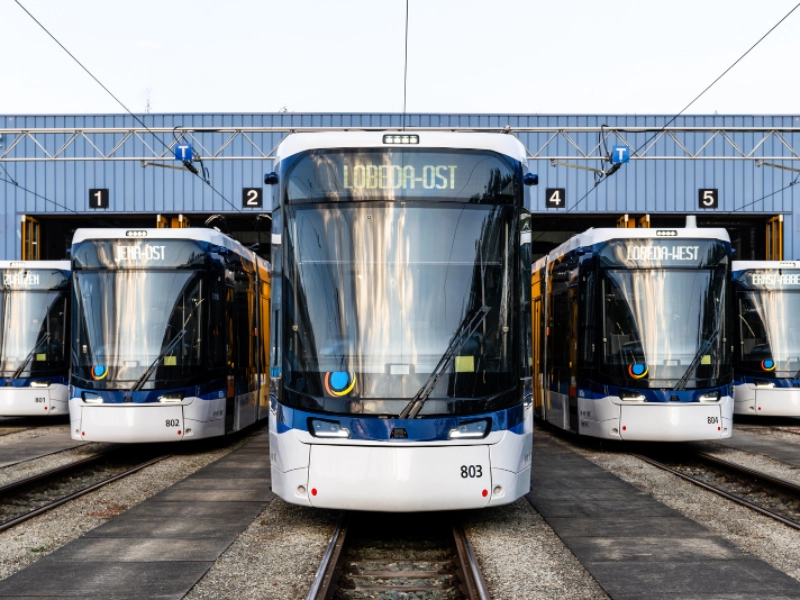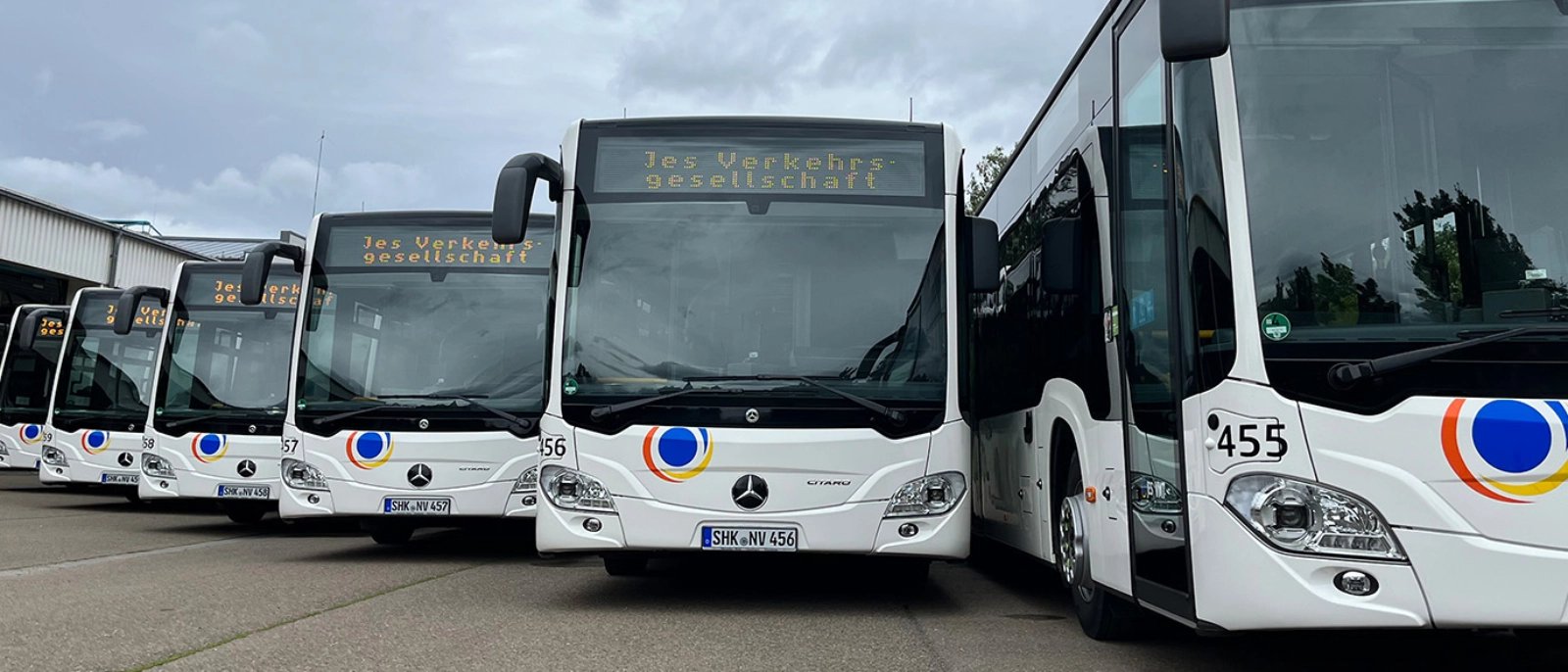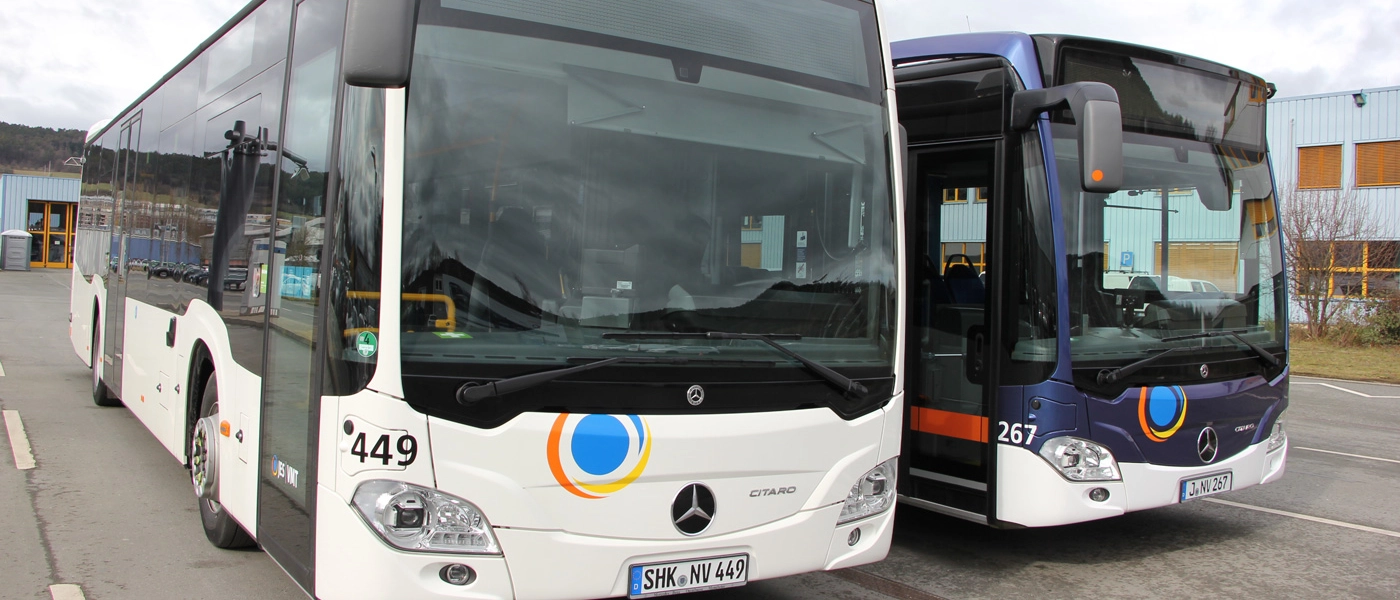Jenaer Nahverkehr GmbH

Chronicle of the Jena public transport
1 April 1901
State police acceptance of the first completed routes.
6 April 1901
Start of public tram service with 17 motor cars, four trailers and four goods wagons. Commissioning of the line headquarters - Holzmarkt - Schubertsburg.
15 April until 25 June 1901
Successive commissioning of the lines: Train station Saalbahnhof - Weimar-Geraer-train station; Steinweg - Mühltal; Weimar-Geraer-train station - Ölmühle and headquarters - Zwätzen
1908
The fare is a standard tariff of 10 Pfennig without transfer entitlement.
30 June 1908
On the occasion of the 350th anniversary of the foundation of the university, the first network extension takes place. The line from Schubertsburg is extended along Kahlaische Straße to Burgau.
1 January 1909
The first conductors are appointed on the tram trains. The tickets are now available in a graduated tariff of 10 to 30 pfennigs. The transfer ticket and the first weekly and monthly tickets for workers and pupils are introduced.
3 August 1909
The Holzmarkt becomes a central tram junction.
1910
After nine years of intensive use of the tram tracks, the first maintenance work is being carried out on the tracks.
1911
Ten railcars receive electric heating. However, the drivers still work on an open platform in all weathers.
1 June 1949
The final separation of railway operations and electrical power generation is decided. Foundation of the "VEB (K) Städtischer Verkehr Jena".
1951
The first delivery of new tram vehicles made in GDR arrives: two motor coaches and two sidecars of the "LOWA-WERDAU" type.
1954
The years from 1954 onwards are marked by an upswing, as well as new vehicles and extensive construction work to improve the infrastructure of the tramway and local public transport. The planning of a new depot is under discussion.
1955
The first six H6B buses are running on the bus routes.
1958
Introduction of sight card railcars for holders of seasonal tickets. The driver checks at the boarding gate. Conductors are now only in the sidecars.
1959 – 1961
The Ernst-Thälmann-Ring (today Löbdergraben), Teichgraben and Holzmarkt, are generously redesigned.
1961 – 1962
Double-track extension of the line between Scharnhorststraße and the hospital. The Paradiesbahnhof-Felsenkeller line is also opened for double-track tram traffic.
15 May 1963
Discontinuation of tram line 3 (Westbahnhof - Holzmarkt - Saalbahnhof).
1964
The line is extended from the former terminus at Zwätzen Schleife. With the construction of the reversing loop, one-way vehicles can be used in Jena for the first time.
1 June 1969
The bus line 16 Mühltal - Neu-Lobeda starts operation. The share of passenger transport with the now extensive bus fleet grows with the development and settlement of the new housing areas Lobeda-West, Lobeda-Ost and Winzerla.
16 June 1969
Due to construction progress of the motorway to Lobeda and the construction of the combined heat and power plant in Winzerla, the operation of the tram line between Alt-Lobeda and Winzerla is discontinued.
23 June 1969
Commissioning of the Winzerla reversing loop.
until 1971
Double-track extension of the tram line to Jena Nord as far as Milchhof. On the lines to Lobeda, buses often run at one-minute intervals.
1974
Completion of the motor transport depot in Burgau. The municipal transport company parks its buses here as a tenant.
1975
The old pay boxes are replaced by print validators.
1976
Railcar No. 26 is transferred from Eisenach to Jena and presented to the public on the occasion of the 75th anniversary of the Jena public transport company.
1977
The tram network still has 28 railcars and 52 sidecars. The bus fleet comprises 93 vehicles of the types Ikarus 66 to 280. For comparison: In 1960, 16 buses were in service.
1984
The double-track extension of the line to Winzerla begins.
27 September 1987
Line 1 runs again from Zwätzen to Winzerla, line 2 between Jena-Ost and Holzmarkt.
1 July 1990
The Jenaer Nahverkehrsgesellschaft mbH is founded from the VEB Städtischer Nahverkehr Jena.
December 1991
New technology is introduced in the bus sector. The first low-floor buses, three Mercedes Benz buses and five MAN NG 272 articulated buses, are used for passenger transport.
1991
The tramway lines 1 and 2 are renewed in sections. The double-tracked roadbeds are overhauled and new stop areas are created. The reversing loop in Zwätzen receives new tracks and a low-floor platform.
16 July 1993
The ground-breaking ceremony for the construction of the new tramway line takes place in the Lobeda district, in Erlanger Allee.
1994
Introduction of the computerised operations control system (RBL).
1995
The existing workshop complex and the parking facilities for the tram vehicles in Dornburger Straße (depot built in 1901) and Clara-Zetkin-Straße (extension of the depot from 1938) are getting completely renovated. The redesign of the bus fleet has been completed. Now 39 modern low-floor buses in various designs are on the road.
16 December 1995
Ceremonial presentation of the first low-floor tram in Jena.
1996
By July, all ten low-floor trams of the first batch have been delivered.
16 December 1996
Ceremonial opening of the first section of the new line between Winzerla and Lobeda.
1997
Another nine low-floor vehicles are delivered this year by the railway technology company Adtranz. The new vehicles, now 19 in total, are not enough to secure the traffic. The "old" Gotha vehicles remain in service.
16 December 1997
Ceremonial opening of the new tram line to Lobeda-Ost and Lobeda-West through Oberaue. At the same time, the newly designed inner city area is opened to the public for trams.
16 July 1998
Laying of the foundation stone for the construction of the workshop building at the new depot in Jena-Burgau.
16 December 1999
Inauguration of the Customer Service Centre in the Holzmarkt-Passage.
Spring 2011
New models of stand-alone ticket machines replace the long-standing machines at the stops in Winzerla, Lobeda and the city centre.
July 2011
On 11 July 2011, Jena's local transport authority and Solaris signed a contract for the delivery of five Solaris trams (Solaris Tramino Jena). These are three-car bi-directional vehicles with low-floor technology.
October 2011
Opening of the art exhibition "Frank Stella-New Works" in the Old Tram Depot in Dornburger Straße
April 2012
The Jena tramway turns 111 - celebrated with an open day on 2 June 2012.
Summer holidays 2012
Rehabilitation of the Knebelstraße track triangle and the Oberaue track interchange.
Summer holidays 2013
Rehabilitation of the tram tracks at the Holzmarkt track triangle and renewal of the tracks in the Red Tower curve area.
11 January 2014
The Tramino goes on its maiden voyage with 60 invited guests.
Mid March 2014
The party track gets a new look, Köstritzer is the new sponsor.
May 2014
Friedrich Schiller University presents the artist Peter Halley with the exhibition "Prisons" in the Old Tram Depot
8 July 2014
Dismissal of Udo Beran as Managing Director - Appointment of Thomas Zaremba as Managing Director.
Summer holidays 2014
Redevelopment of the railway triangle in Lobeda.
November 2014
The first customer advisory board of the Jena public transport system is appointed.
14 December 2014
Start of service of the new bus lines 42 and 43 to the south of Jena and extension of bus line 13 to Maua.
2 July 2015
Outside announcers on vehicles of the Jena public transport system are put into operation.
Summer holidays 2015
Renovation of the railway triangle Kupferhütchen.
April 2016
Exhibition "Quantum Songs" by the artist ROTRAUT in the Old Tram Depot
11 December 2016
New service of bus lines 10/11/12 via the Beutenberg, reorganisation of bus lines in the south of Jena
May 2017
Exhibition "Into the Wood" by artist Georg Thumbach in the Old Tram Depot
10 June 2017
Open day at the Burgau depot
10 December 2017
Improvement of night services - lines 1, 2 and 10 run around the clock; lines 33, 34 and 35 are cancelled
Introduction of mobile ticket in the app MeinJena
Summer holidays 2018
Renovation of railway triangle Winzerla
July 2018
Commissioning of the new bus terminus in Göschwitz
November 2018
Introduction of the service "stop on demand" on all tram and bus lines
September 2018
The Partybahn has a new sponsor and will be operating as the Ur-Krostitzer Partybahn in future
February 2020
The first three e-buses are used on line 15
from March 2020
The Corona pandemic has local transport and the city firmly in its grip: Drastic restrictions in public life will lead to a considerable slump in demand from mid-March 2020. The most important lines run according to a special timetable with considerably restricted services until mid-April.
JES Verkehrsgesellschaft mbH

Cronicle of the JES Verkehrsgesellschaft
13 November 1992
Foundation of JES Verkehrsgesellschaft with headquarters in Jena
13 April 1994
Eisenberg town line turns one year old, ticket costs DM 1
1994
Connection of the centres of Jena, Eisenberg, Hermsdorf and Stadtroda every hour and school holiday ticket sold with digital wristwatches for 10 DM
1995
Redesign of Eisenberg bus station
30 May 1997
Move into the newly built depot in Eisenberg
2000
Corporate Advisory Board established at JES
1 March 2005
Provision of the regular senior citizens' bus to GLOBUS in Hermsdorf
2005
Start of the shuttle service for the 1st Christmas Valley
December 2007
Cooperation agreement between JES and the Jena public transport system
2010
JES joins the VMT for the Saale-Holzland district
November 2010
Re-opening of the bus station in Jena
March 2013
Andreas Möller becomes Managing Director
2014
Procurement of 13 new low-floor regular buses in one year and redesign of the route network in main lines, secondary lines and school transport.
2015
Further major investment in 10 new low-floor scheduled buses
December 2015
Installation of a large-scale photovoltaic system in cooperation with BürgerEnergie
16. December 2021
Steffen Gundermann is the new Managing Director of JES Verkehrsgesellschaft - this results in the same dual leadership as with Jenaer Nahverkehr
1. January 2022
JES becomes subsidiary of Jenaer Nahverkehr
7. July 2022
Acquisition of six new Citaro-buses by EvoBus/Mercedes Benz
14. March 2023
JES and JNV get a joint logo
3. June 2023
Open day at the depots in Jena and Eisenberg
2. August 2023
Acquisition of six new Citaro-buses by EvoBus/Mercedes Benz
2024 to present: A joint venture
April 1, 2024
Merger of the companies to form a joint venture
November 2025
Introduction of energy management with certification


